Low Profile Monopole Meander Line Antenna for WLAN Applications
Abstract
1. Introduction
| Ref. | Frequency (GHz) | Gain (dBi) | Radiation Efficiency (%) | Return Loss (S11) dB | Bandwidth (MHz) | Dimension (mm3) |
|---|---|---|---|---|---|---|
| [23] | 2.4 | 1.34 | 79 | −19.11 | 146 | 40 × 10 × 1.6 |
| [24] | 2.4 | 1.97 | 97 | - | - | 38 × 10.8 × 0.8 |
| [25] | 2.4 | 1.8 | - | −52 | 0.135 | 16 × 32.5 × 1.6 |
| [26] | 2.5 | 1.2 | - | −25 | 200 | 10 × 19 × 1.6 |
| [27] | 2.45 | 2.06 | 75 | −19 | 11 | 39 × 39 × 0.508 |
| [28] | 2.45 | 1.26 | 70 | −10 | 970 | 40 × 30 × 0.787 |
| [29] | 2.4 | 1.33 | 65.3 | - | 180 | 12.45 × 13.05 × 0.8 |
| [30] | 2.45 | 1.78 | - | - | 235 | 19 × 31 × 1.58 |
| [31] | 2.45 | 1.47 | 88 | −17 | - | 29 × 13.7 × 1.5 |
| Proposed work | 2.43 | 2.8 | 97 | −20 | 94.2 | 15 × 90.86 × 1.575 |
2. Antenna Geometry
3. Working Principles
Current Distribution
4. Parametric Study
4.1. Upper Meander Line Length
4.2. Middle Meander Line Length
4.3. Lower Meander Line Length
5. Results and Discussion
6. Conclusions
Author Contributions
Funding
Institutional Review Board Statement
Informed Consent Statement
Data Availability Statement
Conflicts of Interest
Abbreviations
| olv | optimum line value |
| dlv | decrement line value |
| ilv | increment line value |
References
- Li, F.; Ren, L.-S.; Zhao, G.; Jiao, Y.-C. Compact Triple-Band Monopole Antenna with C-Shaped and S-Shaped Meander Strips for WLAN/WIMAX Applications. Prog. Electromagn. Res. Lett. 2010, 15, 107–116. [Google Scholar] [CrossRef]
- Ibrahim, H.H.; Singh, M.S.J.; Al-Bawri, S.S.; Islam, M.T. Synthesis, Characterization and Development of Energy Harvesting Techniques Incorporated with Antennas: A Review Study. Sensors 2020, 20, 2772. [Google Scholar] [CrossRef] [PubMed]
- Mokhtar, N.H.M.; Malek, N.A.; Jusoh, A.Z.; Ali, K.; Isa, F.N.M.; Rahman, F.D.A. Design and comparison of printed antennas using meander line technique. Bull. Electr. Eng. Inform. 2019, 8, 596–603. [Google Scholar] [CrossRef]
- Ahmad, H.; Zaman, W.; Rahman, M.; Seman, F.C. The Smallest Form Factor Monopole Antenna with Meandered Radiator for WLAN and WiMAX Applications. IETE J. Res. 2020, 1–9. [Google Scholar] [CrossRef]
- Manchanda, S.; Hatwar, M.; Abhishek, B. Design of Meander Line Antenna for Operating Frequency of 2.5 GHz. Int. J. Comput. Appl. 2014, 93, 33–36. [Google Scholar]
- Lizzi, L.; Ferrero, F.; Monin, P.; Danchesi, C.; Boudaud, S. Design of miniature antennas for IoT applications. In Proceedings of the 2016 IEEE Sixth International Conference on Communications and Electronics (ICCE), Ha long, Vietnam, 27–29 July 2016; pp. 234–237. [Google Scholar]
- Santos, H.M.; Pinho, P.; Silva, R.P.; Pinheiro, M.; Salgado, H.M. Meander-Line Monopole Antenna with Compact Ground Plane for a Bluetooth System-in-Package. IEEE Antennas Wirel. Propag. Lett. 2019, 18, 2379–2383. [Google Scholar] [CrossRef]
- Ullah, S.; Ruan, C.; Sadiq, M.S.; Haq, T.U.; He, W. High Efficient and Ultra Wide Band Monopole Antenna for Microwave Imaging and Communication Applications. Sensors 2019, 20, 115. [Google Scholar] [CrossRef]
- Alam, T.; Almutairi, A.F.; Samsuzzaman, M.; Cho, M.; Islam, M.T. Metamaterial array based meander line planar antenna for cube satellite communication. Sci. Rep. 2021, 11, 14087. [Google Scholar] [CrossRef]
- Ullah, S.; Ruan, C.; Sadiq, M.S.; Haq, T.U.; Fahad, A.K.; He, W. Super Wide Band, Defected Ground Structure (DGS), and Stepped Meander Line Antenna for WLAN/ISM/WiMAX/UWB and other Wireless Communication Applications. Sensors 2020, 20, 1735. [Google Scholar] [CrossRef]
- Le, T.T.; Yun, T.-Y. Miniaturization of a Dual-Band Wearable Antenna for WBAN Applications. IEEE Antennas Wirel. Propag. Lett. 2020, 19, 1452–1456. [Google Scholar] [CrossRef]
- Ojo, R.; Jamlos, M.F.; Soh, P.J.; Bahari, N.; Lee, Y.S.; Al-Bawri, S.S.; Karim, M.S.A.; Khairi, K.A. A triangular MIMO array antenna with a double negative metamaterial superstrate to enhance bandwidth and gain. Int. J. RF Microw. Comput. Eng. 2020, 30, e22320. [Google Scholar] [CrossRef]
- Radiom, S.; Baghaei-Nejad, M.; Aghdam, K.; Vandenbosch, G.A.E.; Zheng, L.-R.; Gielen, G.G.E. Far-Field On-Chip Antennas Monolithically Integrated in a Wireless-Powered 5.8-GHz Downlink/UWB Uplink RFID Tag in 0.18-μm Standard CMOS. IEEE J. Solid-State Circuits 2010, 45, 1746–1758. [Google Scholar] [CrossRef]
- Alqadami, A.S.M.; Stancombe, A.E.; Bialkowski, K.S.; Abbosh, A. Flexible Meander-Line Antenna Array for Wearable Electromagnetic Head Imaging. IEEE Trans. Antennas Propag. 2020, 69, 4206–4211. [Google Scholar] [CrossRef]
- Al-Dulaimi, Z.; A Elwi, T.; Atilla, D.C. Design of a Meander Line Monopole Antenna Array Based Hilbert-Shaped Reject Band Structure for MIMO Applications. IETE J. Res. 2020, 1–10. [Google Scholar] [CrossRef]
- Moniruzzaman, M.; Islam, M.T.; Samsuzzaman, M.; Salaheldeen, M.; Sahar, N.M.; Al-Bawri, S.S.; Almalki, S.H.A.; Alsaif, H.; Islam, M.S. Gap coupled symmetric split ring resonator based near zero index ENG metamaterial for gain improvement of monopole antenna. Sci. Rep. 2022, 12, 7406. [Google Scholar] [CrossRef]
- Shabbir, T.; Islam, M.T.; Misran, N.; Al-Bawri, S.S.; Singh, S. Broadband single-layer reflectarray antenna loaded with meander-delay-lines for X-band applications. Alex. Eng. J. 2020, 60, 1105–1112. [Google Scholar] [CrossRef]
- Al-Bawri, S.S.; Islam, M.T.; Singh, M.J.; Jamlos, M.F.; Narbudowicz, A.; Ammann, M.J.; Schreurs, D.M.M.P. RSS-Based Indoor Localization System with Single Base Station. Comput. Mater. Contin. 2022, 70, 5437–5452. [Google Scholar] [CrossRef]
- Al-Bawri, S.S.; Jamlos, M.F.; Soh, P.J.; Aljunid Syed Junid, S.A.; Jamlos, M.A.; Narbudowicz, A. Multiband slot-loaded dipole antenna for WLAN and LTE-A applications. IET Microw. Antennas Propag. 2018, 12, 63–68. [Google Scholar] [CrossRef]
- Al-Bawri, S.S.; Islam, M.S.; Wong, H.Y.; Jamlos, M.F.; Narbudowicz, A.; Jusoh, M.; Sabapathy, T.; Islam, M.T. Metamaterial Cell-Based Superstrate towards Bandwidth and Gain Enhancement of Quad-Band CPW-Fed Antenna for Wireless Applications. Sensors 2020, 20, 457. [Google Scholar] [CrossRef]
- Rahman, M.; Islam, S.; Islam, M.T.; Al-Bawri, S.S.; Yong, W.H. Metamaterial-Based Compact Antenna with Defected Ground Structure for 5G and Beyond. Comput. Mater. Contin. 2022, 71, 2383–2399. [Google Scholar]
- Bohari, S.; Faudzi, N.M.; Razali, A.R.; Mozi, A.M.; Zakaria, F.F.; Ilyas, M.Z. Compact Meandered Monopole Antenna for Dual-Bands WLAN Application. J. Phys.: Conf. Ser. 2021, 1962, 012039. [Google Scholar] [CrossRef]
- Islam, M.S.; Islam, M.T.; Ullah, M.A.; Beng, G.K.; Amin, N.; Misran, N. A Modified Meander Line Microstrip Patch Antenna with Enhanced Bandwidth for 2.4 GHz ISM-Band Internet of Things (IoT) Applications. IEEE Access 2019, 7, 127850–127861. [Google Scholar] [CrossRef]
- Koohestani, M.; Tissier, J.; Latrach, M. A compact wideband ACS-fed monopole antenna for wireless applications around 2.45 GHz. In Proceedings of the 13th European Conference on Antennas and Propagation (EuCAP), Krakow, Poland, 31 March–5 April 2019; pp. 1–3. [Google Scholar]
- Al-Bawri, S.S.; Jamlos, M.F. Design of Low-Profile Patch Antenna Incorporated with Double Negative Metamaterial Structure. In Proceedings of the 2018 IEEE International RF and Microwave Conference (RFM), Penang, Malaysia, 17–19 December 2018; pp. 45–48. [Google Scholar]
- Naidu, P.V.; Kumar, A.; Rajkumar, R. Design, analysis and fabrication of compact dual band uniplanar meandered ACS fed antenna for 2.5/5 GHz applications. Microsyst. Technol. 2018, 25, 97–104. [Google Scholar] [CrossRef]
- Arif, A.; Zubair, M.; Ali, M.; Khan, M.U.; Mehmood, M.Q. A Compact, Low-Profile Fractal Antenna for Wearable on-Body WBAN Applications. IEEE Antennas Wirel. Propag. Lett. 2019, 18, 981–985. [Google Scholar] [CrossRef]
- Sahoo, R.; Vakula, D. Compact metamaterial inspired conformal dual-band antenna loaded with meander lines and fractal shaped inductor for Wi-Fi and WiMAX applications. IET Microw. Antennas Propag. 2019, 13, 2349–2359. [Google Scholar] [CrossRef]
- Liu, W.; Xu, L.; Zhan, H. Design of 2.4 GHz/5 GHz planar dual-band electrically small slot antenna based on impedance matching circuit. AEU-Int. J. Electron. Commun. 2018, 83, 322–328. [Google Scholar] [CrossRef]
- Chen, S.; Dong, D.; Liao, Z.; Cai, Q.; Liu, G. Compact wideband and dual-band antenna for TD-LTE and WLAN applications. Electron. Lett. 2014, 50, 1111–1112. [Google Scholar] [CrossRef]
- Othman, N.; Samsuri, N.A.; Rahim, M.K.A.; Kamardin, K.; Majid, H.A. Meander bowtie Antenna for Wearable Application. TELKOMNIKA 2018, 16, 1522–1526. [Google Scholar] [CrossRef][Green Version]
- Ogherohwo, E.P.; Mado, S.D.; Eggah, M.Y. Design and analysis of meander microstrip antenna at wireless band. Int. J. Comput. Appl. 2015, 111, 1–4. [Google Scholar] [CrossRef]
- Ibrahim, H.H.; Singh, M.J.; Al-Bawri, S.S.; Ibrahim, S.K.; Islam, M.T.; Alzamil, A.; Islam, M.S. Radio Frequency Energy Harvesting Technologies: A Comprehensive Review on Designing, Methodologies, and Potential Applications. Sensors 2022, 22, 4144. [Google Scholar] [CrossRef]
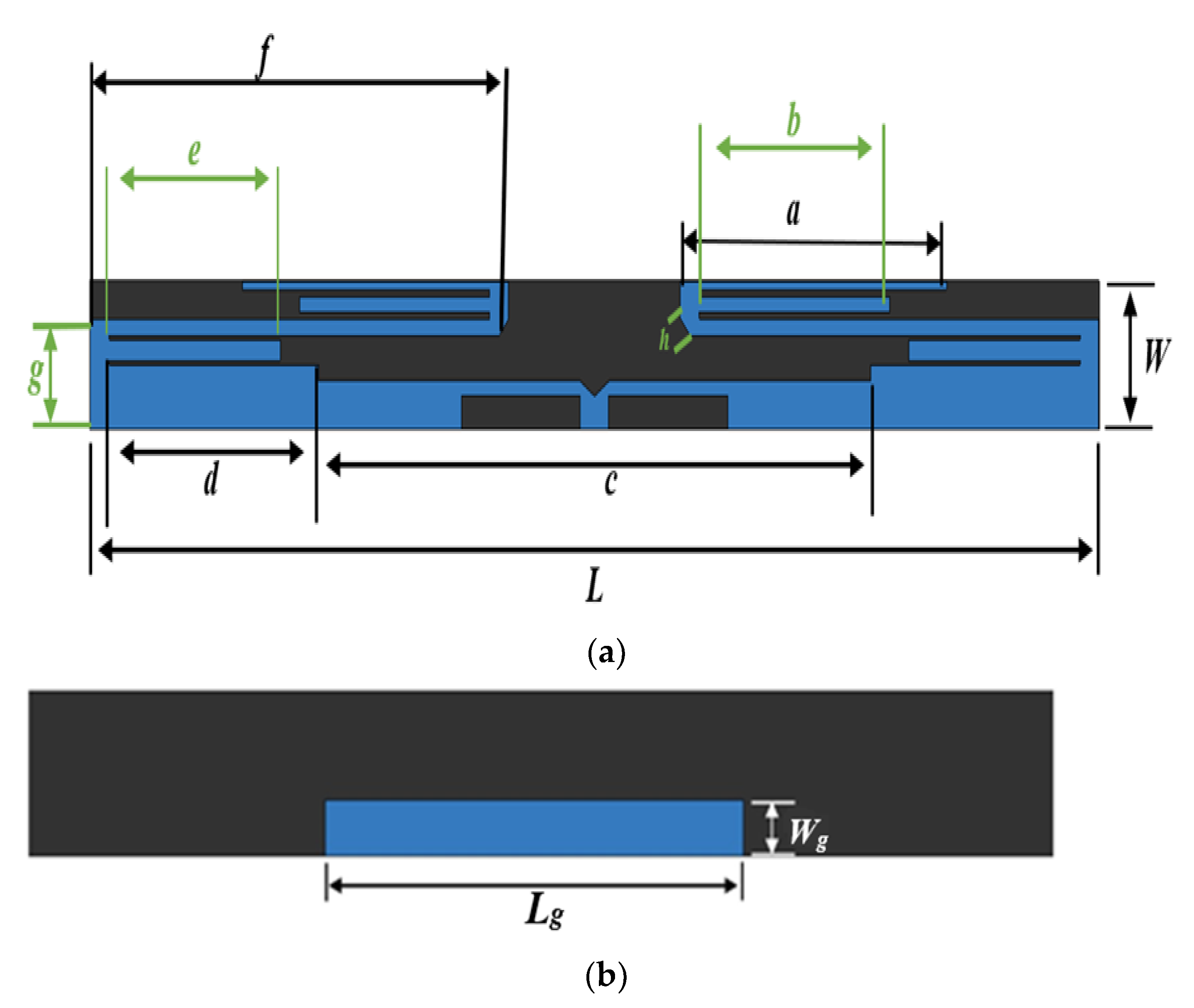
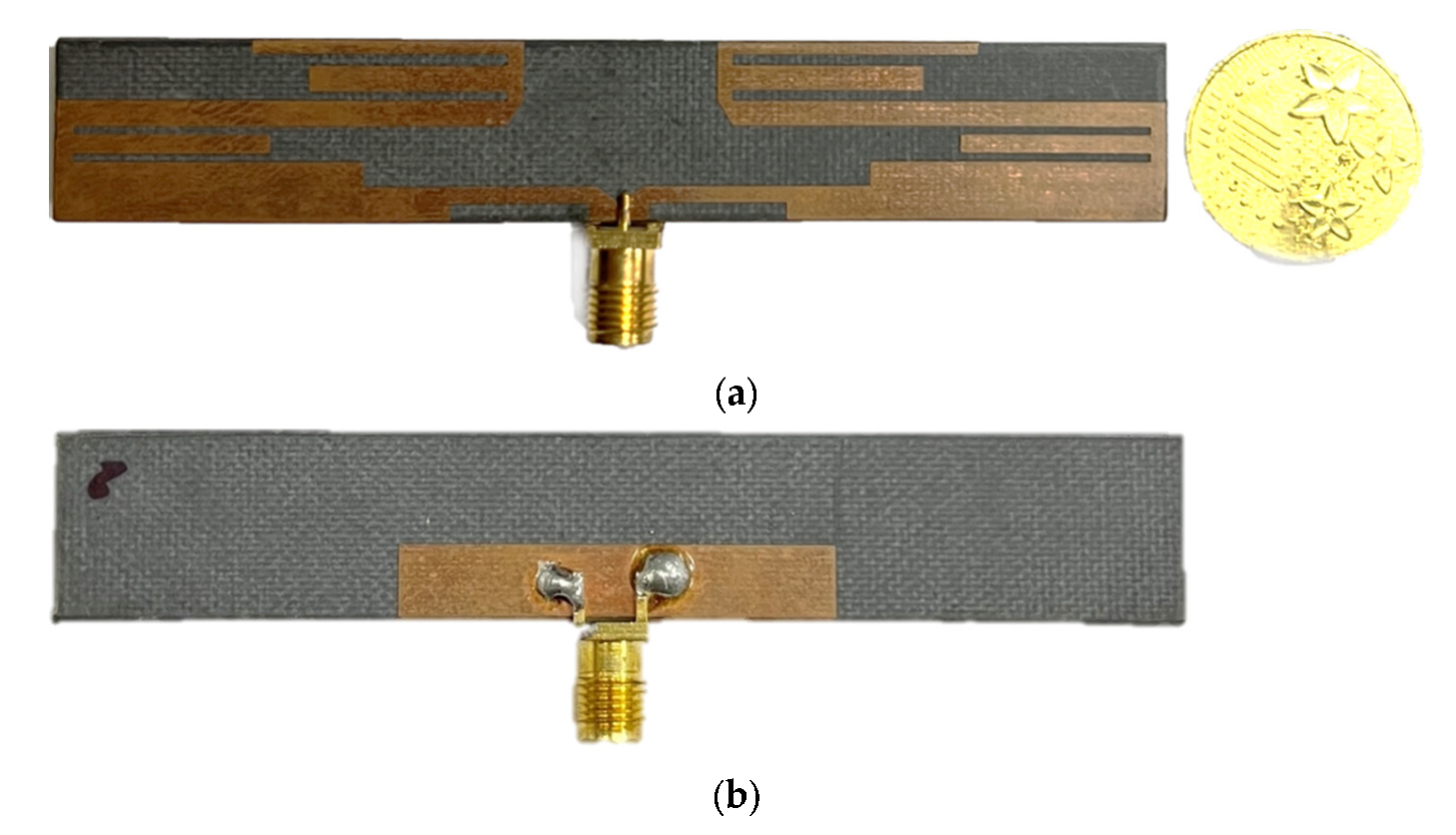

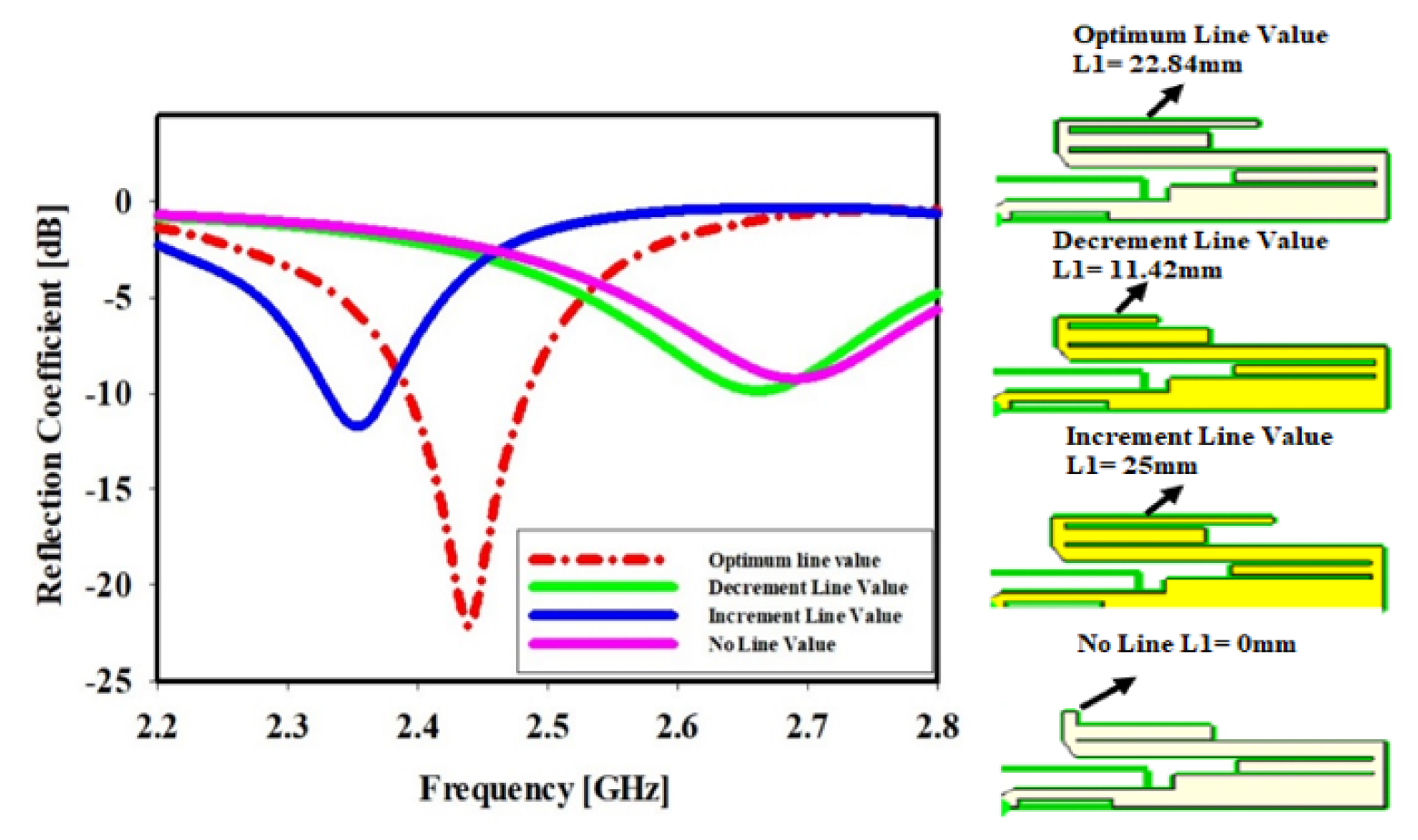
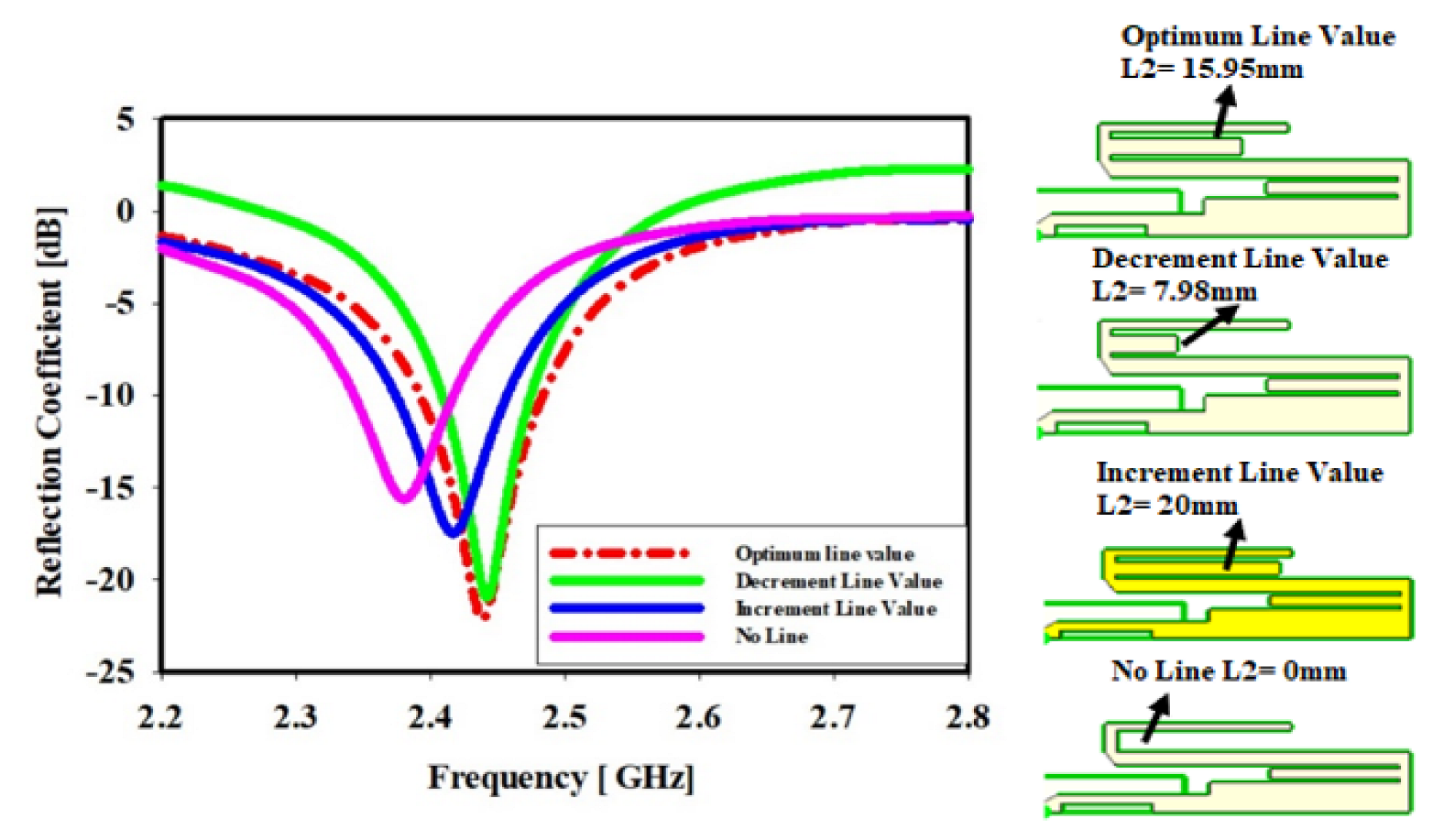
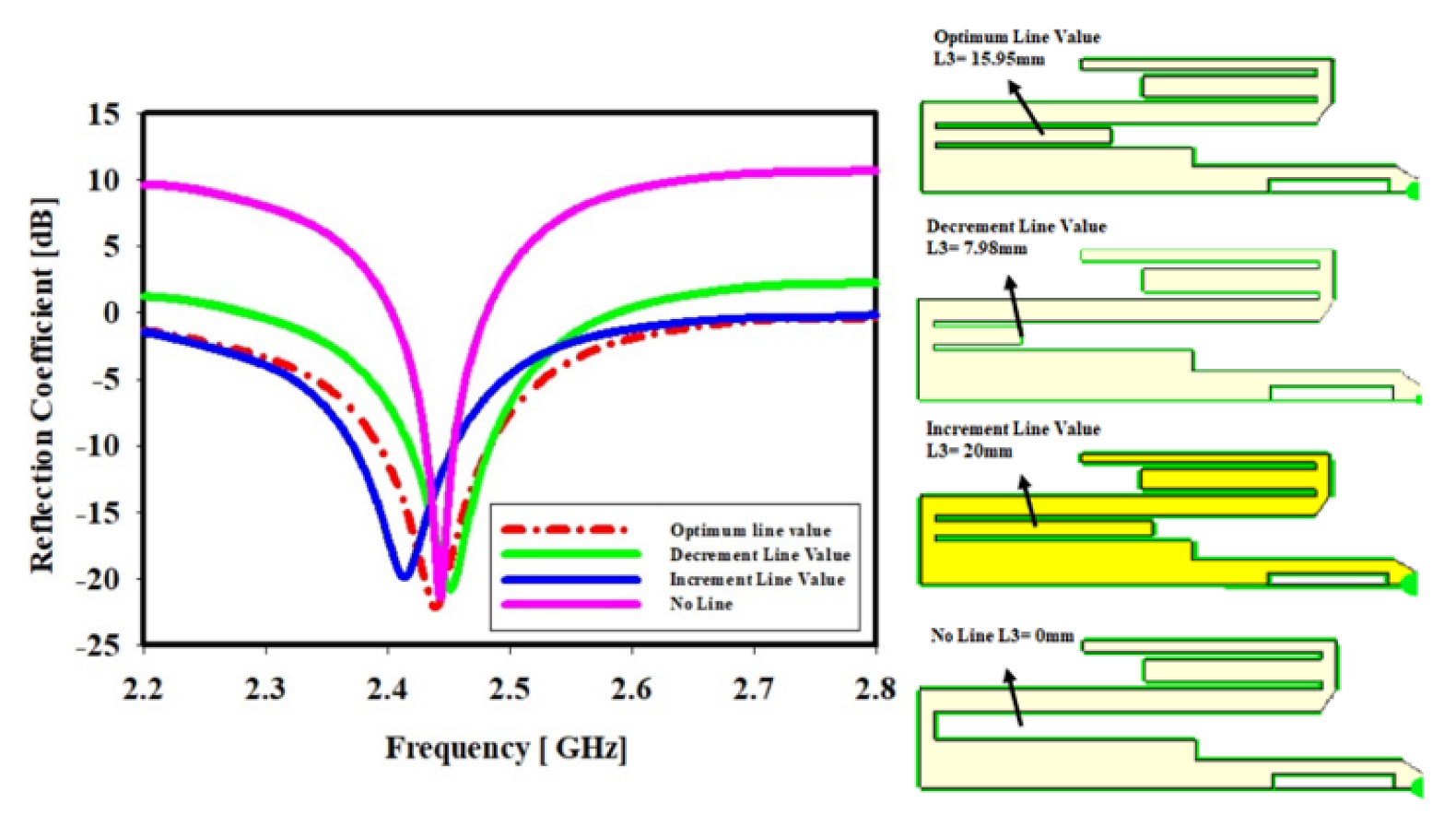
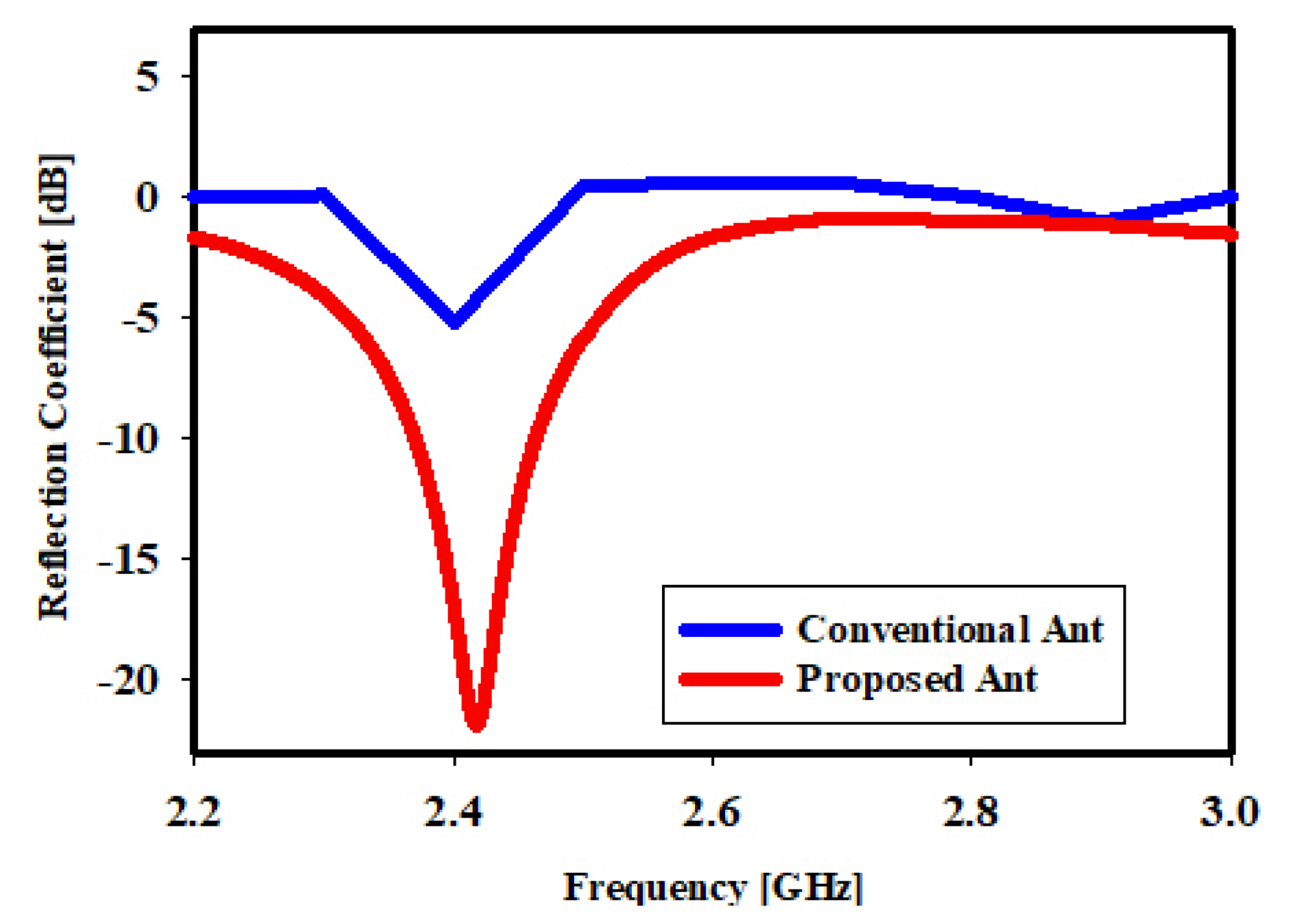

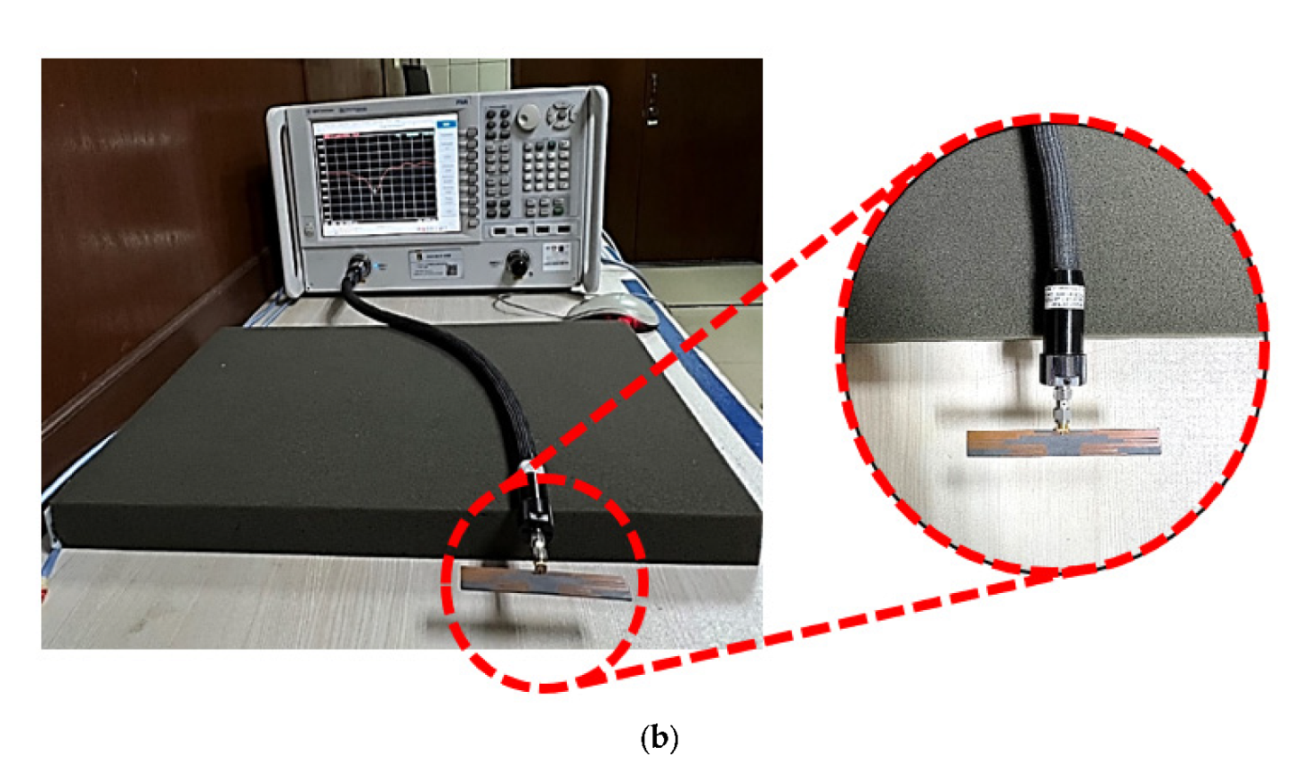
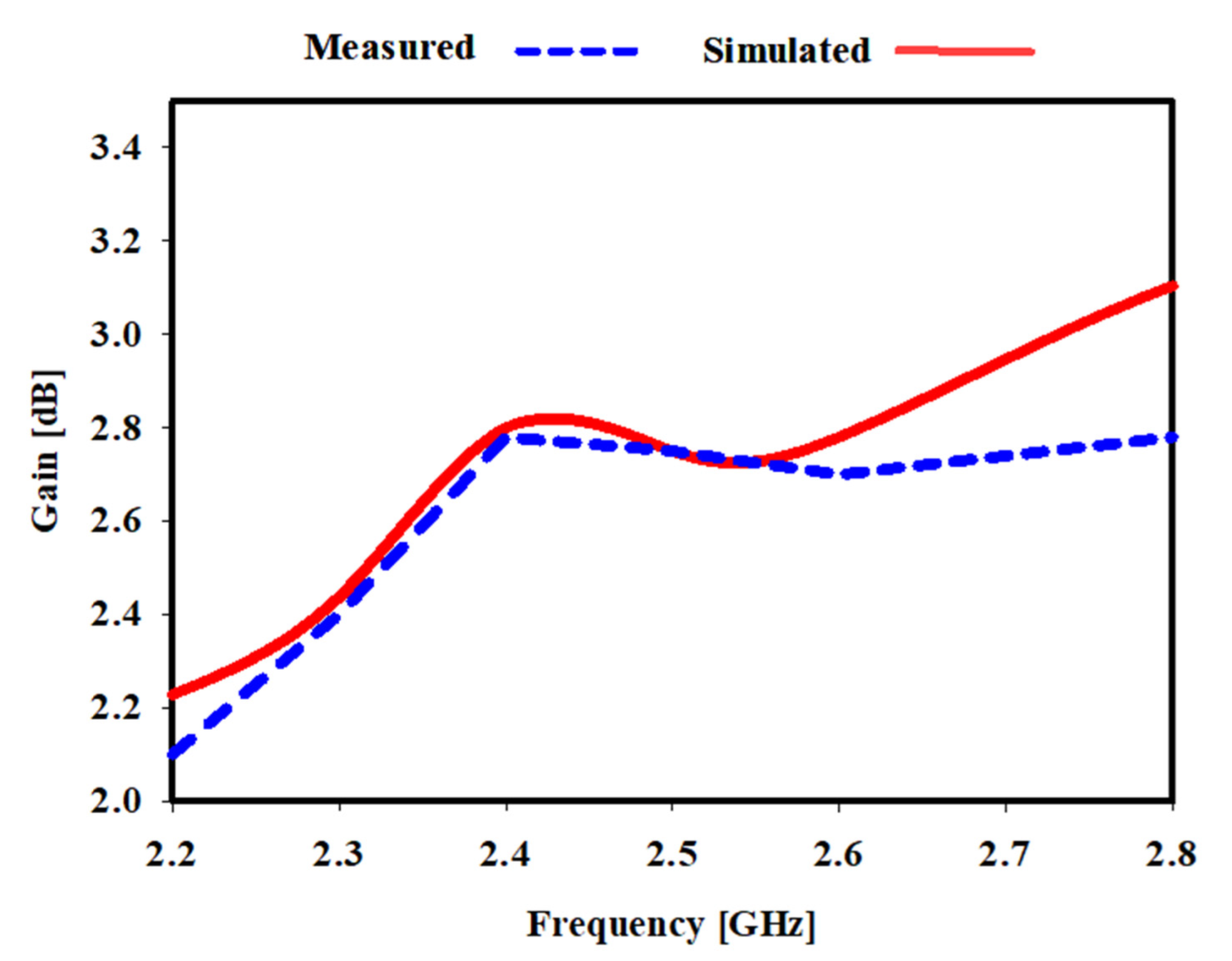
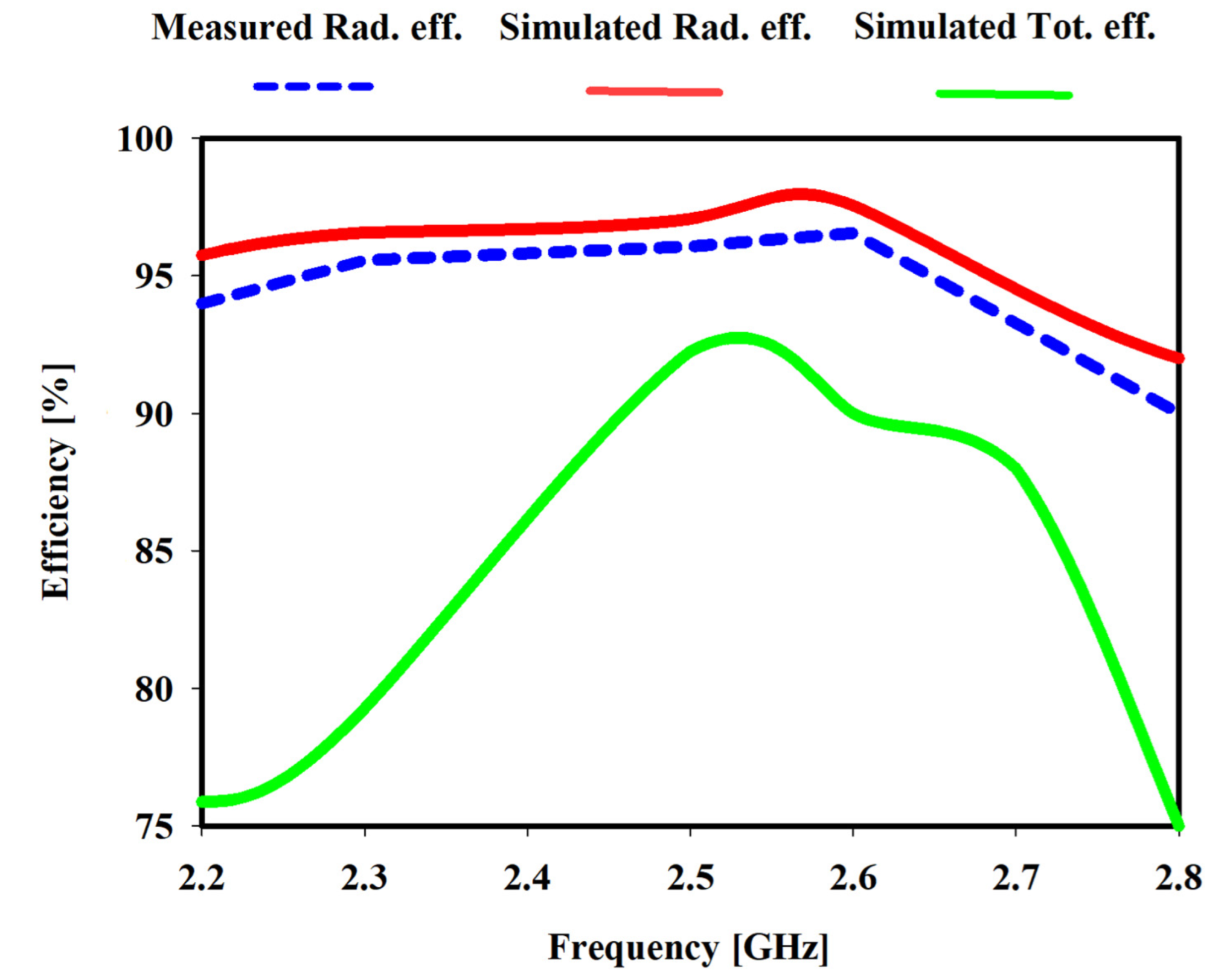

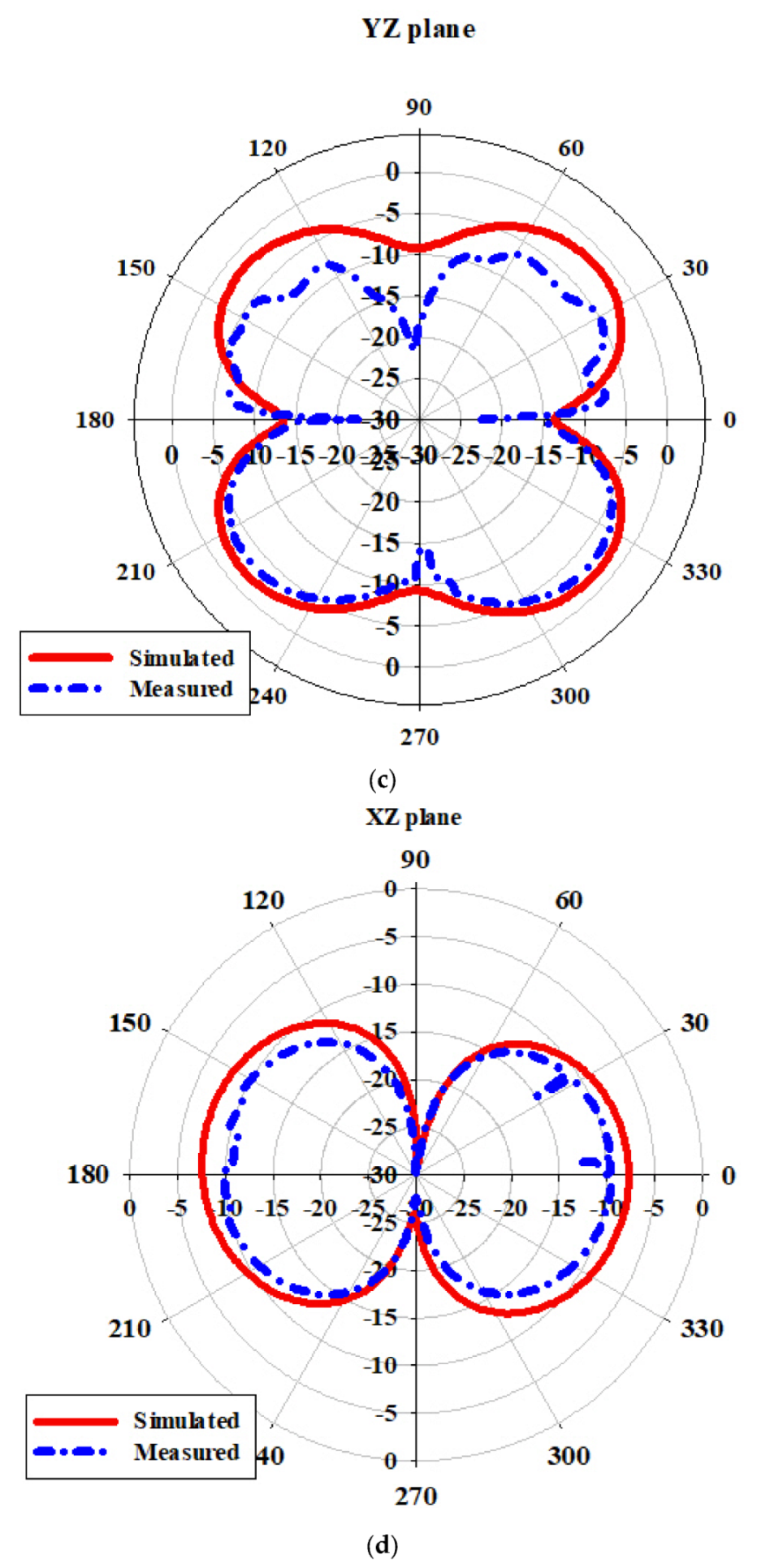
| Parameter | L | W | Lg | Wg | a | b | c | d | e | f | g | h |
|---|---|---|---|---|---|---|---|---|---|---|---|---|
| Dimension (mm) | 90.86 | 15 | 33.3 | 6 | 22.8 | 15.9 | 41.3 | 24.8 | 15.9 | 37.5 | 10 | 2.5 |
Publisher’s Note: MDPI stays neutral with regard to jurisdictional claims in published maps and institutional affiliations. |
© 2022 by the authors. Licensee MDPI, Basel, Switzerland. This article is an open access article distributed under the terms and conditions of the Creative Commons Attribution (CC BY) license (https://creativecommons.org/licenses/by/4.0/).
Share and Cite
Ibrahim, H.H.; Singh, M.J.; Al-Bawri, S.S.; Ibrahim, S.K.; Islam, M.T.; Soliman, M.S.; Islam, M.S. Low Profile Monopole Meander Line Antenna for WLAN Applications. Sensors 2022, 22, 6180. https://doi.org/10.3390/s22166180
Ibrahim HH, Singh MJ, Al-Bawri SS, Ibrahim SK, Islam MT, Soliman MS, Islam MS. Low Profile Monopole Meander Line Antenna for WLAN Applications. Sensors. 2022; 22(16):6180. https://doi.org/10.3390/s22166180
Chicago/Turabian StyleIbrahim, Husam Hamid, Mandeep Jit Singh, Samir Salem Al-Bawri, Sura Khalil Ibrahim, Mohammad Tariqul Islam, Mohamed S. Soliman, and Md Shabiul Islam. 2022. "Low Profile Monopole Meander Line Antenna for WLAN Applications" Sensors 22, no. 16: 6180. https://doi.org/10.3390/s22166180
APA StyleIbrahim, H. H., Singh, M. J., Al-Bawri, S. S., Ibrahim, S. K., Islam, M. T., Soliman, M. S., & Islam, M. S. (2022). Low Profile Monopole Meander Line Antenna for WLAN Applications. Sensors, 22(16), 6180. https://doi.org/10.3390/s22166180








